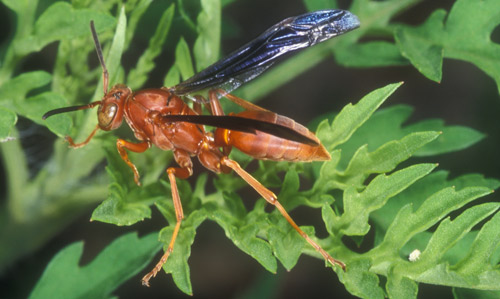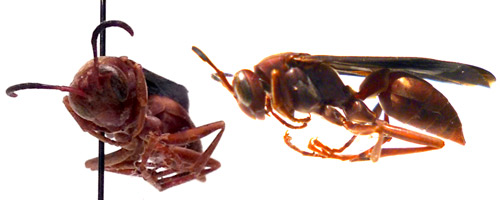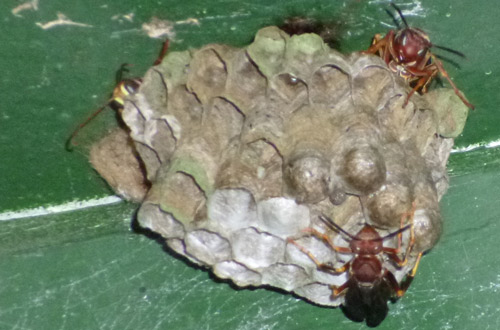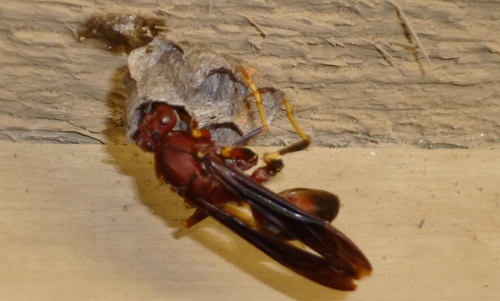common name: paper wasp, red wasp (suggested common names)
scientific name: Polistes carolina (L.) (Insecta: Hymenoptera: Vespidae)
Introduction - Distribution - Identification - Biology - Economic Importance - Management - Selected References
Introduction (Back to Top)
The genus Polistes belongs to the subfamily Polistinae, whose members are known as the paper wasps because of the papery nests the queens build and colonies live in. These wasps are primitively eusocial, characterized by morphologically similar reproductive queens and non-reproductive workers, moderate colony sizes (yielding hundreds of offspring in the most successful nests), and independent founding queens. The subfamily includes 21 genera in the New World, of which Polistes is the most common in North America, represented by 17 species distributed across the warmer regions of the continent. Polistes carolina (Figure 1) and Polistes perplexus are the only ferruginous, or rust-colored, species in the eastern states.
Figure 1. Polistes carolina (L.), Gainesville, Florida, USA. Photograph by Lyle J. Buss, University of Florida.
Distribution (Back to Top)
Polistes carolina is most commonly associated with the eastern and south-central United States, ranging from New York, Ohio, and Pennsylvania, south to Florida and as far west as Arkansas, Illinois, Kansas, and eastern Texas. Richards (1978) and Carpenter (1996) report the species has also been introduced to Bermuda; and Buck et al. (2008) noted its sighting in Ontario, Canada, although probably as an adventive species. They are commonly found in woodlands, from summer through fall.
Identification (Back to Top)
The paper wasps are members of the family Vespidae. In general, they are elongate and slender, characterized by spindle-shaped metasoma and brownish or reddish bodies marked with yellow. Defining features include: forewings with three submarginal cells and no intersections between the first subdiscoidal and medial cells, mid tibiae with two spurs, wide gena that does not taper ventrally, simple tarsal claws, clypeus pointed at the apex, a subtly arched (in profile) metasomal tergum 1, and discrete hair covering the head and body.
Of all the paper wasps, Polistes carolina and Polistes perplexus are the only dominantly ferruginous (rust-colored) species; although sometimes confused with these two species, Polistes metricus has more extensive black markings, prominently on the thorax and legs. Polistes carolina (Figure 2) females differ from those of Polistes perplexus by their nearly glabrous malar space and lower gena; the malar space and gena of Polistes perplexus are covered with sparse, silvery pubescence. Males are distinguished by the coarser transverse ridging of the propodeum in Polistes perplexus than in Polistes carolina. Polistes carolina also tends to have more black markings on the thorax than does Polistes perplexus.
Figure 2. Rostral (left) and lateral (right) views of Polistes carolina (L.). Note the uniform ferruginous color; finely ridged propodeum; and bare malar space, lower gena, and thorax. Photographs by Lizzie Paulus, University of Florida.
The forewing length in both sexes of Polistes carolina is 15 to 20.5 mm. The female body is nearly completely rust colored. Possible color variations include dark markings around ocelli (simple eyes), on the distal half of the scape’s dorsum, medially in front of the pronotal carina, forming dashed central and lateral stripes on the scutum, mesosoma, and propodeum. Dark bands can also be present on sternite 2 and tergite 3 and 4. Yellow markings are possible on the mandibles, clypeus, inner orbit, propodeal valvula, tergite 1 and exterior surfaces of the tibiae and tarsi. In contrast, males typically present more defined black or sepia markings on their fore and mid femora and on sternite 3 through 6. While their yellow markings vary greatly, most males’ clypei show a gradient of yellow to ferruginous coloring along the median portion of the dorsal surface. In both sexes, the most ferruginous representatives lack all markings except limited yellow spots on the mesopleuron behind the fore coxae. It is of note that the coloring of this group’s members vary and can make identifying individuals in the field challenging. Close inspection of specimens’ physical structures and behavior are more reliable identification methods.
Biology (Back to Top)
Paper wasps build their nests from wood tissue and saliva, pressing the materials with their mandibles into thin, delicate layers resembling paper that form the nest and comb of hexagonal brood cells (Figure 3). The cells are arranged to orient the growing larvae head-down towards the ground. Typically nests are attached by a pedicel to the protected underside of overhanging structures, such as the eaves of houses (Figure 4) or in hollows of trees.
Figure 3. Growing colony of Polistes spp. with workers tending to cells. Photograph by Lizzie Paulus, University of Florida.
Figure 4. Foundress female building new nest from the eave of a house. Photograph by Lizzie Paulus, University of Florida.
The nest is headed by a reproductive queen and maintained by smaller female workers that lack functional ovaries. Workers forage for wood fibers, nectar, water, and small invertebrates (e.g., caterpillars, cicadas, beetle larvae). They defend the nest using their painful stings.
Inseminated females destined to be queens (gynes) establish new colonies. In temperate areas, these future queens cluster to overwinter in sheltered sites. When spring comes, they start new nests by themselves. These Polistes queens may be joined by sisters, which become subordinate foundresses and fill the roles of workers, suppressing the development of their own ovaries and, consequently, reproductive capability. If the primary foundress dies, one of the subordinate sisters can become queen and assume the reproductive role. The order of arrival to the nest appears to determine the line of succession among potential foundresses. Once established, the successor assumes a greater proportion of the colony’s nutrition and spends more time at the nest, developing fully operational ovaries within a month of her queen’s death.
The foundress queen mates a single time, storing sperm in her spermatheca (reproductive storage organ), and lays fertilized eggs in worker cells; these eggs receive limited amounts of nourishment. These workers mature near the end of fall. Queens then lay unfertilized eggs, which develop into males, and fertilized eggs that, with adequate nutrition, develop into foundress daughters. Males mate with foundress daughters of other nests—rarely their own (Seppä 2002)—and die, leaving the foundress daughters to overwinter. In subtropical and tropical areas, colonies may produce many foundresses and maintain nests for multiple seasons, periodically replacing queens with new foundresses.
Economic Importance (Back to Top)
Gardeners and agricultural workers consider Polistes carolina to be a beneficial insect because it pollinates plants and crops when feeding on plant nectar, and preys on some plant pests, including caterpillars, cicadas, and beetle larvae.
Management (Back to Top)
Despite their economic benefit to agriculture, no documented attempts to rear Polistes carolina exist. In fact, the species’ predilection to build nests on or around residential houses and the possibility of stings convince some homeowners that the wasps are hazards. This species, however, is not particularly aggressive and typically stings only when threatened. If the nest needs to be destroyed, it is easiest to do so in the evening when the wasps are inactive. There are many commercially available aerosol insecticides meant for hornets and wasps. Follow the label instructions, and avoid using aerosolized or spray insecticides near open flames. If the nest is just starting with a single queen, it may be unnecessary to spray her and the nest. Instead, remove the nest or knock it down with a broom; the queen will likely start a nest elsewhere.
Swatting or vacuuming can dispatch single wasps, or insecticide aerosols may be used from a distance, according to the label instructions. Alternatively, people who regularly encounter wasps may opt to wear long sleeves, pants, gloves, and a beekeeping veil to protect themselves from stings. Again, however, paper wasps in general and Polistes carolina in particular are not aggressive, only stinging when threatened.
Selected References (Back to Top)
- Bambara SB, Waldvogel M. 2004. Controlling paper wasps in and around structures. North Carolina State University Department of Entomology, North Carolina Cooperative Extension. ENT/rsc-9.
- Borror DJ, White RE. 1970. A field guide to insects. Houghton Mifflin, New York, USA.
- Buck M, Marshall SA, Cheung DKB. 2008. Identification atlas of the Vespidae (Hymenoptera, Aculeata) of the northeastern Nearctic Region. Canadian Journal of Arthropod Identification 5: 492.
- Carpenter JM. 1996. Distributional checklist of species of the genus Polistes (Hymenoptera: Vespidae; Polistinae, Polistini). American Museum Novitates 3188: 1-39.
- Hahn J, Pellitteri P, Lewis D. 2009. Wasp and bee control. University of Minnesota Extension.
- Hunt JH. 2011. A conceptual model for the origin of worker behaviour and adaptation of eusoclialty. Journal of Evolutionary Biology 25: 1-19.
- Johnson NF, Triplehorn CA. 2005. Borror and DeLong's Introduction to the Study of Insects. Belmont: Brooks/Cole, Cengage Learning.
- Richards OW. 1963. The species of Pseudomasaris Ashmead (Hymenoptera, Masaridae). University of California Publications in Entomology 27: 283-304.
- Seppä P, Queller DC, Strassman JE. 2002. Reproduction in foundress associations of the social wasp, Polistes carolina: Conventions, competition, and skew. Behavioral Ecology 13: 531-542.
- Strassman JE, Fortunato A, Cervo R, Turillazzi S, Damon J, Queller DC. 2004. The cost of queen loss in the social wasp Polistes dominulus (Hymenoptera: Vespidae). Journal of the Kansas Entomological Society 77: 343-355.



